Hacking has been a part of computing for almost five decades and it is a very broad discipline, which covers a wide range of topics. The first known event of hacking had taken place in 1960 at MIT and at the same time, the term "Hacker" was originated. In this tutorial, we will take you through the various concepts of Ethical Hacking and explain how you can use them in a real-time environment.
Thursday 20 September 2018
Ethical Hacking - Useful Resources
The following resources contain additional information on Ethical Hacking. Please use them to get more in-depth knowledge on this.
Useful Links on Ethical Hacking
- Ethical Hacking Wiki − Wikipedia Reference for Ethical Hacking.
Useful Books on Ethical Hacking
Ethical Hacking - Pen Testing
Penetration Testing is a method that many companies follow in order to minimize their security breaches. This is a controlled way of hiring a professional who will try to hack your system and show you the loopholes that you should fix.
Before doing a penetration test, it is mandatory to have an agreement that will explicitly mention the following parameters −
- what will be the time of penetration test,
- where will be the IP source of the attack, and
- what will be the penetration fields of the system.
Penetration testing is conducted by professional ethical hackers who mainly use commercial, open-source tools, automate tools and manual checks. There are no restrictions; the most important objective here is to uncover as many security flaws as possible.
Types of Penetration Testing
We have five types of penetration testing −
- Black Box − Here, the ethical hacker doesn’t have any information regarding the infrastructure or the network of the organization that he is trying to penetrate. In black-box penetration testing, the hacker tries to find the information by his own means.
- Grey Box − It is a type of penetration testing where the ethical hacker has a partial knowledge of the infrastructure, like its domain name server.
- White Box − In white-box penetration testing, the ethical hacker is provided with all the necessary information about the infrastructure and the network of the organization that he needs to penetrate.
- External Penetration Testing − This type of penetration testing mainly focuses on network infrastructure or servers and their software operating under the infrastructure. In this case, the ethical hacker tries the attack using public networks through the Internet. The hacker attempts to hack the company infrastructure by attacking their webpages, webservers, public DNS servers, etc.
- Internal Penetration Testing − In this type of penetration testing, the ethical hacker is inside the network of the company and conducts his tests from there.
Penetration testing can also cause problems such as system malfunctioning, system crashing, or data loss. Therefore, a company should take calculated risks before going ahead with penetration testing. The risk is calculated as follows and it is a management risk.
RISK = Threat × Vulnerability
Example
You have an online e-commerce website that is in production. You want to do a penetration testing before making it live. Here, you have to weigh the pros and cons first. If you go ahead with penetration testing, it might cause interruption of service. On the contrary, if you do not wish to perform a penetration testing, then you can run the risk of having an unpatched vulnerability that will remain as a threat all the time.
Before doing a penetration test, it is recommended that you put down the scope of the project in writing. You should be clear about what is going to be tested. For example −
- Your company has a VPN or any other remote access techniques and you want to test that particular point.
- Your application has webservers with databases, so you might want to get it tested for SQL injection attacks which is one of the most crucial tests on a webserver. In addition, you can check if your webserver is immune to DoS attacks.
Quick Tips
Before going ahead with a penetration test, you should keep the following points in mind −
- First understand your requirements and evaluate all the risks.
- Hire a certified person to conduct penetration test because they are trained to apply all the possible methods and techniques to uncover possible loopholes in a network or web application.
- Always sign an agreement before doing a penetration test.
Ethical Hacking - SQL Injection
SQL injection is a set of SQL commands that are placed in a URL string or in data structures in order to retrieve a response that we want from the databases that are connected with the web applications. This type of attacks generally takes place on webpages developed using PHP or ASP.NET.
An SQL injection attack can be done with the following intentions −
- To dump the whole database of a system,
- To modify the content of the databases, or
- To perform different queries that are not allowed by the application.
This type of attack works when the applications don’t validate the inputs properly, before passing them to an SQL statement. Injections are normally placed put in address bars, search fields, or data fields.
The easiest way to detect if a web application is vulnerable to an SQL injection attack is to use the " ‘ " character in a string and see if you get any error.
Example 1
Let’s try to understand this concept using a few examples. As shown in the following screenshot, we have used a " ‘ " character in the Name field.
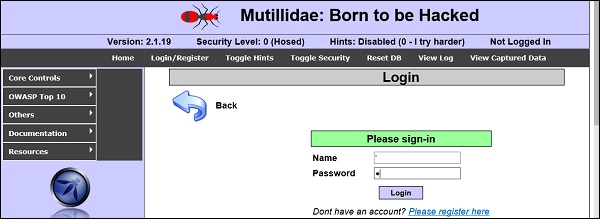
Now, click the Login button. It should produce the following response −

It means that the “Name” field is vulnerable to SQL injection.
Example 2
We have this URL − http://10.10.10.101/mutillidae/index.php?page=site-footer-xssdiscussion.php
And we want to test the variable “page” but observe how we have injected a " ‘ " character in the string URL.
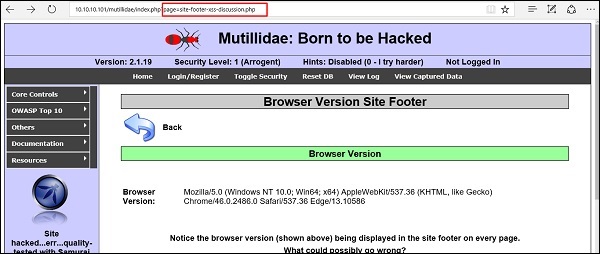
When we press Enter, it will produce the following result which is with errors.
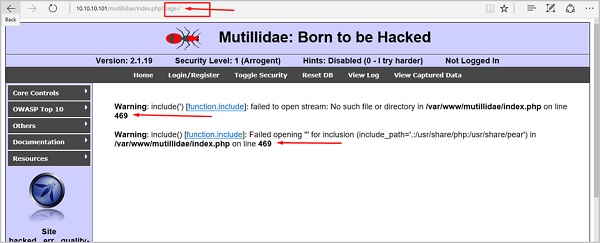
SQLMAP
SQLMAP is one of the best tools available to detect SQL injections. It can be downloaded from http://sqlmap.org/
It comes pre-compiled in the Kali distribution. You can locate it at − Applications → Database Assessment → Sqlmap.
After opening SQLMAP, we go to the page that we have the SQL injection and then get the header request. From the header, we run the following command in SQL −
./sqlmap.py --headers="User-Agent: Mozilla/5.0 (X11; Ubuntu; Linux i686; rv:25.0) Gecko/20100101 Firefox/25.0" --cookie="security=low; PHPSESSID=oikbs8qcic2omf5gnd09kihsm7" -u ' http://localhost/dvwa/vulnerabilities/sqli_blind/?id=1&Submit=Submit#' - level=5 risk=3 -p id --suffix="-BR" -v3
The SQLMAP will test all the variables and the result will show that the parameter “id” is vulnerable, as shown in the following screenshot.
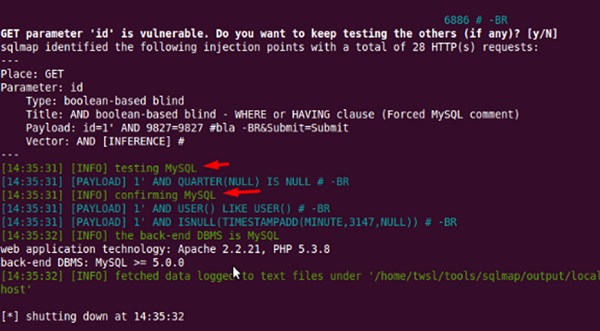
SQLNinja
SQLNinja is another SQL injection tool that is available in Kali distribution.
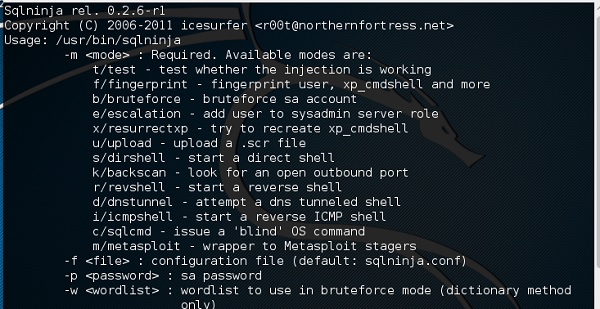
JSQL Injection
JSQL Injection is in Java and it makes automated SQL injections.
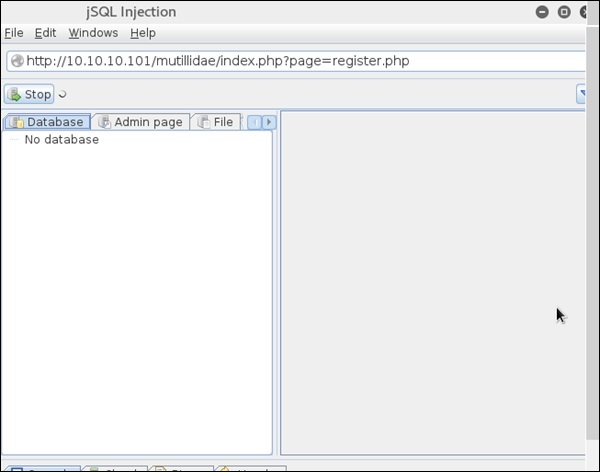
Quick Tips
To prevent your web application from SQL injection attacks, you should keep the following points in mind −
- Unchecked user-input to database should not be allowed to pass through the application GUI.
- Every variable that passes into the application should be sanitized and validated.
- The user input which is passed into the database should be quoted.
Ethical Hacking - Cross-Site Scripting
Cross-site scripting (XSS) is a code injection attack that allows an attacker to execute malicious JavaScript in another user's browser.
The attacker does not directly target his victim. Instead, he exploits a vulnerability in a website that the victim visits, in order to get the website to deliver the malicious JavaScript for him. To the victim's browser, the malicious JavaScript appears to be a legitimate part of the website, and the website has thus acted as an unintentional accomplice to the attacker. These attacks can be carried out using HTML, JavaScript, VBScript, ActiveX, Flash, but the most used XSS is malicious JavaScript.
These attacks also can gather data from account hijacking, changing of user settings, cookie theft/poisoning, or false advertising and create DoS attacks.
Example
Let’s take an example to understand how it works. We have a vulnerable webpage that we got by the metasploitable machine. Now we will test the field that is highlighted in red arrow for XSS.
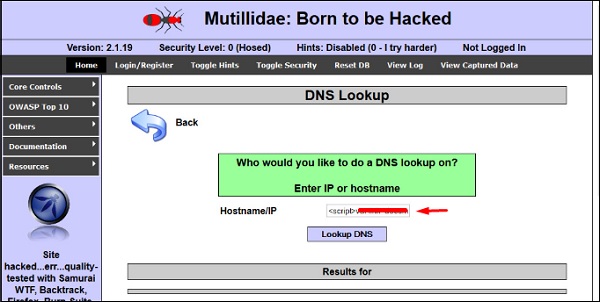
First of all, we make a simple alert script
<script> alert(‘I am Vulnerable’) </script>
It will produce the following output −
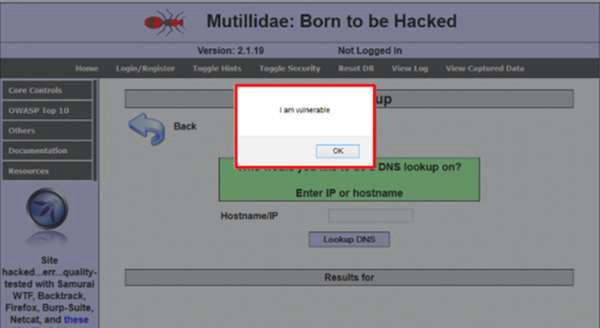
Types of XSS Attacks
XSS attacks are often divided into three types −
- Persistent XSS, where the malicious string originates from the website's database.
- Reflected XSS, where the malicious string originates from the victim's request.
- DOM-based XSS, where the vulnerability is in the client-side code rather than the server-side code.
Generally, cross-site scripting is found by vulnerability scanners so that you don’t have to do all the manual job by putting a JavaScript on it like
<script> alert('XSS') </script>
Burp Suite and acunetix are considered as the best vulnerability scanners.
Quick Tip
To prevent XSS attacks, keep the following points in mind −
- Check and validate all the form fields like hidden forms, headers, cookies, query strings.
- Implement a stringent security policy. Set character limitation in the input fields.
Ethical Hacking - DDOS Attacks
A Distributed Denial of Service (DDoS) attack is an attempt to make an online service or a website unavailable by overloading it with huge floods of traffic generated from multiple sources.
Unlike a Denial of Service (DoS) attack, in which one computer and one Internet connection is used to flood a targeted resource with packets, a DDoS attack uses many computers and many Internet connections, often distributed globally in what is referred to as a botnet.
A large scale volumetric DDoS attack can generate a traffic measured in tens of Gigabits (and even hundreds of Gigabits) per second. We are sure your normal network will not be able to handle such traffic.
What are Botnets?
Attackers build a network of hacked machines which are known as botnets, by spreading malicious piece of code through emails, websites, and social media. Once these computers are infected, they can be controlled remotely, without their owners' knowledge, and used like an army to launch an attack against any target.
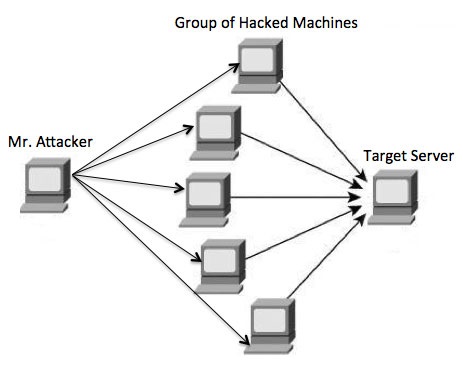
A DDoS flood can be generated in multiple ways. For example −
- Botnets can be used for sending more number of connection requests than a server can handle at a time.
- Attackers can have computers send a victim resource huge amounts of random data to use up the target's bandwidth.
Due to the distributed nature of these machines, they can be used to generate distributed high traffic which may be difficult to handle. It finally results in a complete blockage of a service.
Types of DDoS Attacks
DDoS attacks can be broadly categorized into three categories −
- Volume-based Attacks
- Protocol Attacks
- Application Layer Attacks
Volume-Based Attacks
Volume-based attacks include TCP floods, UDP floods, ICMP floods, and other spoofedpacket floods. These are also called Layer 3 & 4 Attacks. Here, an attacker tries to saturate the bandwidth of the target site. The attack magnitude is measured in Bits per Second (bps).
- UDP Flood − A UDP flood is used to flood random ports on a remote host with numerous UDP packets, more specifically port number 53. Specialized firewalls can be used to filter out or block malicious UDP packets.
- ICMP Flood − This is similar to UDP flood and used to flood a remote host with numerous ICMP Echo Requests. This type of attack can consume both outgoing and incoming bandwidth and a high volume of ping requests will result in overall system slowdown.
- HTTP Flood − The attacker sends HTTP GET and POST requests to a targeted web server in a large volume which cannot be handled by the server and leads to denial of additional connections from legitimate clients.
- Amplification Attack − The attacker makes a request that generates a large response which includes DNS requests for large TXT records and HTTP GET requests for large files like images, PDFs, or any other data files.
Protocol Attacks
Protocol attacks include SYN floods, Ping of Death, fragmented packet attacks, Smurf DDoS, etc. This type of attack consumes actual server resources and other resources like firewalls and load balancers. The attack magnitude is measured in Packets per Second.
- DNS Flood − DNS floods are used for attacking both the infrastructure and a DNS application to overwhelm a target system and consume all its available network bandwidth.
- SYN Flood − The attacker sends TCP connection requests faster than the targeted machine can process them, causing network saturation. Administrators can tweak TCP stacks to mitigate the effect of SYN floods. To reduce the effect of SYN floods, you can reduce the timeout until a stack frees memory allocated to a connection, or selectively dropping incoming connections using a firewall or iptables.
- Ping of Death − The attacker sends malformed or oversized packets using a simple ping command. IP allows sending 65,535 bytes packets but sending a ping packet larger than 65,535 bytes violates the Internet Protocol and could cause memory overflow on the target system and finally crash the system. To avoid Ping of Death attacks and its variants, many sites block ICMP ping messages altogether at their firewalls.
Application Layer Attacks
Application Layer Attacks include Slowloris, Zero-day DDoS attacks, DDoS attacks that target Apache, Windows or OpenBSD vulnerabilities and more. Here the goal is to crash the web server. The attack magnitude is measured in Requests per Second.
- Application Attack − This is also called Layer 7 Attack, where the attacker makes excessive log-in, database-lookup, or search requests to overload the application. It is really difficult to detect Layer 7 attacks because they resemble legitimate website traffic.
- Slowloris − The attacker sends huge number of HTTP headers to a targeted web server, but never completes a request. The targeted server keeps each of these false connections open and eventually overflows the maximum concurrent connection pool, and leads to denial of additional connections from legitimate clients.
- NTP Amplification − The attacker exploits publically-accessible Network Time Protocol (NTP) servers to overwhelm the targeted server with User Datagram Protocol (UDP) traffic.
- Zero-day DDoS Attacks − A zero-day vulnerability is a system or application flaw previously unknown to the vendor, and has not been fixed or patched. These are new type of attacks coming into existence day by day, for example, exploiting vulnerabilities for which no patch has yet been released.
How to Fix a DDoS Attack
There are quite a few DDoS protection options which you can apply depending on the type of DDoS attack.
Your DDoS protection starts from identifying and closing all the possible OS and application level vulnerabilities in your system, closing all the possible ports, removing unnecessary access from the system and hiding your server behind a proxy or CDN system.
If you see a low magnitude of the DDoS, then you can find many firewall-based solutions which can help you in filtering out DDoS based traffic. But if you have high volume of DDoS attack like in gigabits or even more, then you should take the help of a DDoS protection service provider that offers a more holistic, proactive and genuine approach.
You must be careful while approaching and selecting a DDoS protection service provider. There are number of service providers who want to take advantage of your situation. If you inform them that you are under DDoS attack, then they will start offering you a variety of services at unreasonably high costs.
We can suggest you a simple and working solution which starts with a search for a good DNS solution provider who is flexible enough to configure A and CNAME records for your website. Second, you will need a good CDN provider that can handle big DDoS traffic and provide you DDoS protection service as a part of their CDN package.
Assume your server IP address is AAA.BBB.CCC.DDD. Then you should do the following DNS configuration −
- Create a A Record in DNS zone file as shown below with a DNS identifier, for example, ARECORDID and keep it secret from the outside world.
- Now ask your CDN provider to link the created DNS identifier with a URL, something like cdn.someotherid.domain.com.
- You will use the CDN URL cdn.someotherid.domain.com to create two CNAME records, the first one to point to www and the second record to point to @ as shown below.
You can take the help from your system administrator to understand these points and configure your DNS and CDN appropriately. Finally, you will have the following configuration at your DNS.
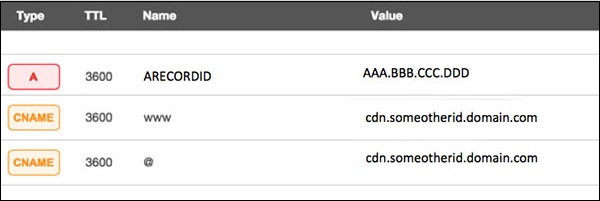
Now, let the CDN provider handle all type of DDoS attacks and your system will remain safe. But here the condition is that you should not disclose your system's IP address or A record identifier to anyone; else direct attacks will start again.
Quick Fix
DDoS attacks have become more common than ever before, and unfortunately, there is no quick fix for this problem. However, if your system is under a DDoS attack, then don’t panic and start looking into the matter step by step.
Ethical Hacking - Social Engineering
Let us try to understand the concept of Social Engineering attacks through some examples.
Example 1
You must have noticed old company documents being thrown into dustbins as garbage. These documents might contain sensitive information such as Names, Phone Numbers, Account Numbers, Social Security Numbers, Addresses, etc. Many companies still use carbon paper in their fax machines and once the roll is over, its carbon goes into dustbin which may have traces of sensitive data. Although it sounds improbable, but attackers can easily retrieve information from the company dumpsters by pilfering through the garbage.
Example 2
An attacker may befriend a company personnel and establish good relationship with him over a period of time. This relationship can be established online through social networks, chatting rooms, or offline at a coffee table, in a playground, or through any other means. The attacker takes the office personnel in confidence and finally digs out the required sensitive information without giving a clue.
Example 3
A social engineer may pretend to be an employee or a valid user or an VIP by faking an identification card or simply by convincing employees of his position in the company. Such an attacker can gain physical access to restricted areas, thus providing further opportunities for attacks.
Example 4
It happens in most of the cases that an attacker might be around you and can do shoulder surfing while you are typing sensitive information like user ID and password, account PIN, etc.
Phishing Attack
A phishing attack is a computer-based social engineering, where an attacker crafts an email that appears legitimate. Such emails have the same look and feel as those received from the original site, but they might contain links to fake websites. If you are not smart enough, then you will type your user ID and password and will try to login which will result in failure and by that time, the attacker will have your ID and password to attack your original account.
Quick Fix
- You should enforce a good security policy in your organization and conduct required trainings to make all the employees aware of the possible Social Engineering attacks and their consequences.
- Document shredding should be a mandatory activity in your company.
- Make double sure that any links that you receive in your email is coming from authentic sources and that they point to correct websites. Otherwise you might end up as a victim of Phishing.
- Be professional and never share your ID and password with anybody else in any case.
Ethical Hacking - Wireless Hacking
A wireless network is a set of two or more devices connected with each other via radio waves within a limited space range. The devices in a wireless network have the freedom to be in motion, but be in connection with the network and share data with other devices in the network. One of the most crucial point that they are so spread is that their installation cost is very cheap and fast than the wire networks.
Wireless networks are widely used and it is quite easy to set them up. They use IEEE 802.11 standards. A wireless router is the most important device in a wireless network that connects the users with the Internet.
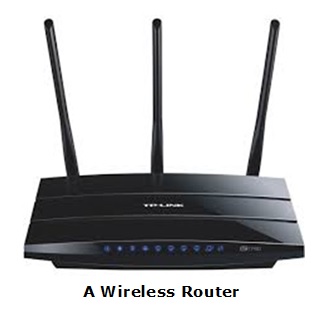
In a wireless network, we have Access Points which are extensions of wireless ranges that behave as logical switches.
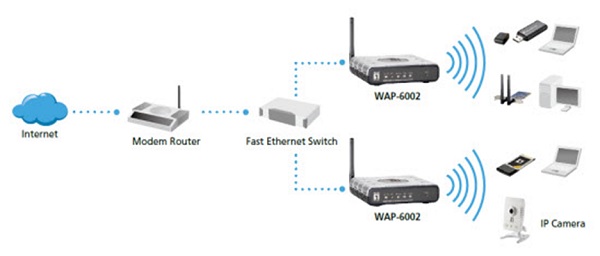
Although wireless networks offer great flexibility, they have their security problems. A hacker can sniff the network packets without having to be in the same building where the network is located. As wireless networks communicate through radio waves, a hacker can easily sniff the network from a nearby location.
Most attackers use network sniffing to find the SSID and hack a wireless network. When our wireless cards are converted in sniffing modes, they are called monitor mode.
Kismet
Kismet is a powerful tool for wireless sniffing that is found in Kali distribution. It can also be downloaded from its official webpage − https://www.kismetwireless.net/index.shtml
Let’s see how it works. First of all, open a terminal and type kismet. Start the Kismet Server and click Yes, as shown in the following screenshot.

As shown here, click the Start button.
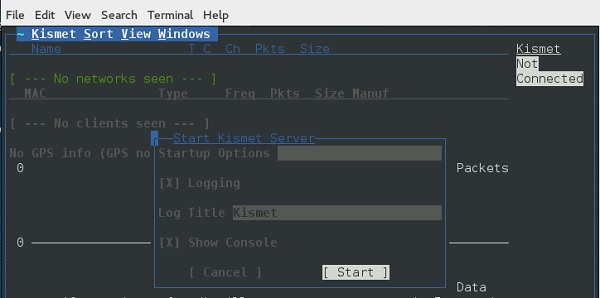
Now, Kismet will start to capture data. The following screenshot shows how it would appear −
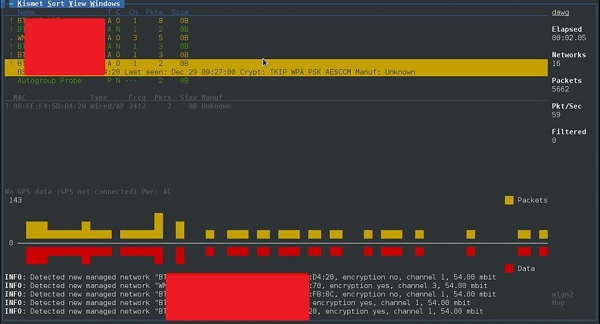
NetStumbler
NetStumbler is another tool for wireless hacking that is primarily meant for Windows systems. It can be downloaded from http://www.stumbler.net/
It is quite easy to use NetStumbler on your system. You just have to click the Scanning button and wait for the result, as shown in the following screenshot.

It should display a screenshot as follows −
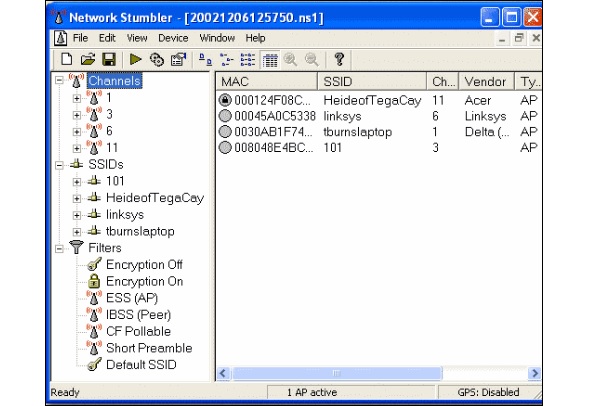
It is important to note that your card should support monitoring mode, otherwise you will fail to monitor.
Wired Equivalent Privacy
Wired Equivalent Privacy (WEP) is a security protocol that was invented to secure wireless networks and keep them private. It utilizes encryption at the data link layer which forbids unauthorized access to the network.
The key is used to encrypt the packets before transmission begins. An integrity check mechanism checks that the packets are not altered after transmission.
Note that WEP is not entirely immune to security problems. It suffers from the following issues −
- CRC32 is not sufficient to ensure complete cryptographic integrity of a packet.
- It is vulnerable to dictionary attacks.
- WEP is vulnerable to Denial of Services attacks too.
WEPcrack
WEPcrack is a popular tool to crack WEP passwords. It can be downloaded from − https://sourceforge.net/projects/wepcrack/
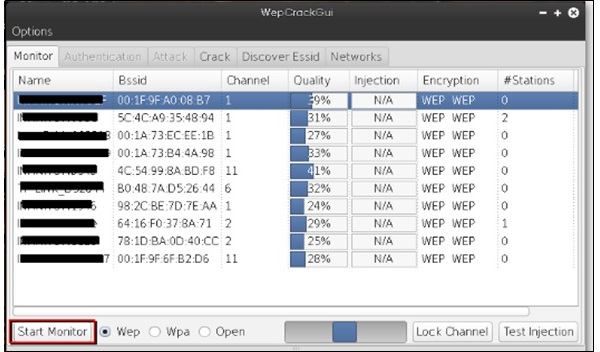
Aircrack-ng
Aircrak-ng is another popular tool for cracking WEP passwords. It can be found in the Kali distribution of Linux.
The following screenshot shows how we have sniffed a wireless network and collected packets and created a file RHAWEP-01.cap. Then we run it with aircrack-ng to decrypt the cypher.
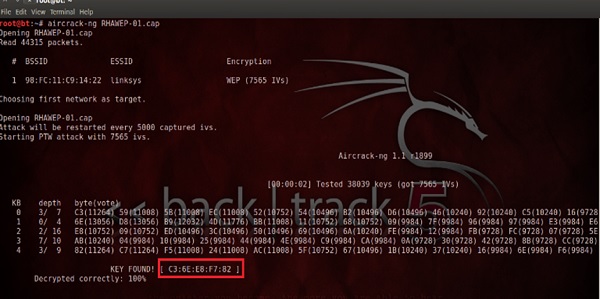
Wireless DoS Attacks
In a wireless environment, an attacker can attack a network from a distance and therefore, it is sometimes difficult to collect evidences against the attacker.
The first type of DoS is Physical Attack. This type of attack is very basic and it is in the base of radio interferences which can be created even from cordless phones that operate in 2.4 GHz range.
Another type is Network DoS Attack. As the Wireless Access Point creates a shared medium, it offers the possibility to flood the traffic of this medium toward the AP which will make its processing more slow toward the clients that attempt to connect. Such attacks can be created just by a ping flood DoS attack.
Pyloris is a popular DoS tool that you can download from − https://sourceforge.net/projects/pyloris/
Low Orbit Ion Cannon (LOIC) is another popular tool for DoS attacks.
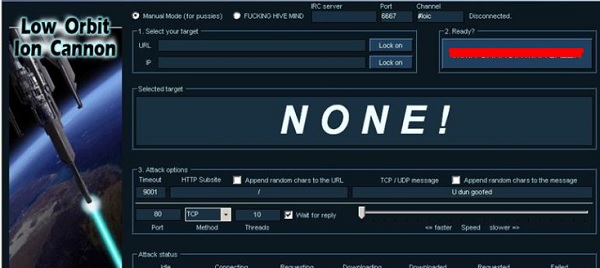
Quick Tips
To secure a wireless network, you should keep the following points in mind −
- Change the SSID and the network password regularly.
- Change the default password of access points.
- Don’t use WEP encryption.
- Turn off guest networking.
- Update the firmware of your wireless device.
Subscribe to:
Posts (Atom)






